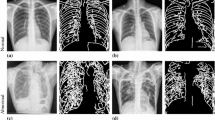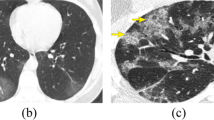Abstract
In recent times, the use of chest X-ray (CXR) images in telemedicine has increased exponentially. However, the transfer of these images on an unsecured channel poses a serious threat to their authenticity and copyright protection. To address this problem, a chest X-ray image watermarking scheme (CXRmark) is presented in this paper using an online sequential reduced kernel extreme learning machine (OS-RKELM). U-Net is used to segment the lung area into the region of non-interest (RONI) and region of interest (ROI). An OS-RKELM is trained using the approximation coefficients (obtained by transforming training images using discrete wavelet transform) and the corresponding quantized coefficients. Subsequently, it is used to modulate the approximation coefficients. In order to avoid inadvertent deterioration in the ROI and to achieve high robustness, the proposed watermarking scheme uses different embedding strengths for ROI and RONI. Further, to enhance the security of the watermark, it has been encoded using the logistic chaotic map. To evaluate the performance of the proposed scheme, we experimented with a set of 461 CXR images from a publicly available repository: COVID-19 Image Data Collection. It has been demonstrated that CXRmark results in high perceptual quality of the signed CXRs and is robust to common interference. Further, the reversibility of the proposed CXRmark scheme is demonstrated by recovering the undistorted CXR image from the signed CXR. The comparison of the proposed scheme with state-of-the-art schemes shows that CXRmark outperforms its competitors in terms of imperceptibility and robustness.















Similar content being viewed by others
Data Availability
The dataset used in this work is publicly available at https://github.com/ieee8023/covid-chestxray-dataset.
References
A. Anand, A.K. Singh, An improved DWT-SVD domain watermarking for medical information security. Comput. Commun. 152, 72–80 (2020)
I. Aouissaoui, A.B. Hmed, F.T. Ouanes, T. Bakir, A. Sakly, Blind integer wavelet transform medical image watermarking based logistic map encryption, in 2019 International Conference on Internet of Things, Embedded Systems and Communications (IINTEC), IEEE, pp. 62–67 (2019)
T.K. Araghi, A. Abd Manaf, An enhanced hybrid image watermarking scheme for security of medical and non-medical images based on DWT and 2-D SVD. Futur. Gener. Comput. Syst. 101, 1223–1246 (2019)
M. Arsalan, A.S. Qureshi, A. Khan, M. Rajarajan, Protection of medical images and patient related information in healthcare: Using an intelligent and reversible watermarking technique. Appl. Soft Comput. 51, 168–179 (2017)
N. Aslani, A. Garavand, The role of telemedicine to control CoVID-19. Arch. Clin. Infect. Dis. 15(COVID–19), e102949 (2020)
R. Bamal, S.S. Kasana, Dual hybrid medical watermarking using walsh-slantlet transform. Multimedia Tools Appl. 78(13), 17899–17927 (2019)
S. Behnia, M. Yahyavi, R. Habibpourbisafar, Watermarking based on discrete wavelet transform and q-deformed chaotic map. Chaos, Solitons Fractals 104, 6–17 (2017)
S. Borra, R. Thanki, A frt-svd based blind medical watermarking technique for telemedicine applications. Int. J. Digital Crime Forens. (IJDCF) 11(2), 13–33 (2019)
S. Boujerfaoui, R. Riad, H. Douzi, F. Ros, R. Harba, Image Watermarking between Conventional and Learning-Based Techniques: A Literature Review. Electronics 12(1), 74 (2022)
E. Candes, J. Romberg, l1-magic: Recovery of sparse signals via convex programming, www.acm.caltech.edu/l1magic/downloads/l1magic.pdf4(14), 16 (2005)
V.G. Chellaiyan, A. Nirupama, N. Taneja, Telemedicine in India: Where do we stand? J. Fam. Med. Primary Care 8(6), 1872 (2019)
J. P. Cohen, P. Morrison, L. Dao, COVID-19 image data collection. arXiv:2003.11597 (2020)
I.J. Cox, J. Kilian, F.T. Leighton, T. Shamoon, Secure spread spectrum watermarking for multimedia. IEEE Trans. Image Process. 6(12), 1673–1687 (1997)
I. Cox, M. Miller, J. Bloom, J, Fridrich, T. Kalker, Digital watermarking and steganography, Morgan kaufmann (2007)
S. Das, M.K. Kundu, Effective management of medical information through ROI-lossless fragile image watermarking technique. Comput. Methods Programs Biomed. 111(3), 662–675 (2013)
W.-Y. Deng, Y.-S. Ong, P.S. Tan, Q.-H. Zheng, Online sequential reduced kernel extreme learning machine. Neurocomputing 174, 72–84 (2016)
W. Deng, Q. Zheng, K. Zhang, Reduced kernel extreme learning machine, in Proceedings of the 8th International Conference on Computer Recognition Systems CORES 2013, Springer, pp. 63–69 (2013)
K. Fares, A. Khaldi, K. Redouane, E. Salah, DCT & DWT based watermarking scheme for medical information security. Biomed. Signal Process. Control 66, 102403 (2021)
P. Fei, , Y.-Z. Lei, C.-T. Li, Y. Li, A reversible watermarking scheme for 2D engineering graphics based on improved quantisation index modulation, in 3rd International Conference on Imaging for Crime Detection and Prevention (ICDP 2009), pp. 1–6 (2009)
J. Hastad, B. Just, J.C. Lagarias, C.-P. Schnorr, Polynomial time algorithms for finding integer relations among real numbers. SIAM J. Comput. 18(5), 859–881 (1989)
H.-T. Hu, T.-T. Lee, Robust complementary dual image watermarking in subbands derived from the laplacian pyramid, discrete wavelet transform, and directional filter bank. Circ. Syst. Signal Process. 41(7), 4090–4116 (2022)
G.-B. Huang, Q.-Y. Zhu, C.-K. Siew, Extreme learning machine: theory and applications. Neurocomputing 70(1–3), 489–501 (2006)
N.N. Hurrah, S.A. Parah, N.A. Loan, J.A. Sheikh, M. Elhoseny, K. Muhammad, Dual watermarking framework for privacy protection and content authentication of multimedia. Futur. Gener. Comput. Syst. 94, 654–673 (2019)
B. Jagadeesh, P.R. Kumar, P.C. Reddy, Robust digital image watermarking based on fuzzy inference system and back propagation neural networks using DCT. Soft. Comput. 20(9), 3679–3686 (2016)
F. Kahlessenane, A. Khaldi, R. Kafi, S. Euschi, A DWT based watermarking approach for medical image protection. J. Ambient. Intell. Humaniz. Comput. 12(2), 2931–2938 (2021)
S. Kumar, A. Rajpal, N.K. Sharma, S. Rajpal, A. Nayyar, N. Kumar, ROSEmark: Robust semi-blind ECG watermarking scheme using SWT-DCT framework. Digital Signal Process. 129, 103648 (2022)
S. Kumar, N.K. Sharma, N. Kumar, WSOmark: An adaptive dual-purpose color image watermarking using white shark optimizer and levenberg-marquardt bpnn. Expert Syst. Appl. 226, 120137 (2023)
M. Kutter, F. A. Petitcolas, Fair benchmark for image watermarking systems, in Security and Watermarking of Multimedia Contents, Vol. 3657, International Society for Optics and Photonics, pp. 226–239 (1999)
L. Li, S. Li, A. Abraham, J.-S. Pan, Geometrically invariant image watermarking using polar harmonic transforms. Inf. Sci. 199, 1–19 (2012)
N.-Y. Liang, G.-B. Huang, P. Saratchandran, N. Sundararajan, A fast and accurate online sequential learning algorithm for feedforward networks. IEEE Trans. Neural Netw. 17(6), 1411–1423 (2006)
Q. Liu, X. Jiang, Design and realization of a meaningful digital watermarking algorithm based on RBF neural network, in 2006 6th World Congress on Intelligent Control and Automation, Vol. 1, IEEE, pp. 2878–2881 (2006)
Y. Luo, F. Wang, J. Liu, L. Li, S. Yang, S. Zhang, COVER: A secure blind image watermarking scheme. Circ. Syst. Signal Process. 41(12), 6931–6959 (2022)
N.A. Memon, A. Alzahrani, Prediction-based reversible watermarking of CT scan images for content authentication and copyright protection. IEEE Access 8, 75448–75462 (2020)
A. Mishra, A. Rajpal, R. Bala, Fast Semi-blind Color Image Watermarking Scheme Using DWT and Extreme Learning Machine, in International Conference on Computational Science and Its Applications, Springer, pp. 63–78 (2017)
N. Mohananthini, G. Yamuna, Watermarking for images using wavelet domain in Back-Propagation neural network, in IEEE-International Conference On Advances In Engineering, Science And Management (ICAESM-2012), IEEE, pp. 100–105 (2012)
A. Mooney, J.G. Keating, D.M. Heffernan, Performance analysis of chaotic and white watermarks in the presence of common watermark attacks. Chaos, Solitons Fractals 42(1), 560–570 (2009)
J. Musić, I. Knežević, E. Franca, Wavelet based watermarking approach in the compressive sensing scenario, in 2015 4th Mediterranean Conference on Embedded Computing (MECO), IEEE, pp. 315–318 (2015)
I. Orović, A. Draganić, S. Stanković, Compressive sensing as a watermarking attack, in 2013 21st Telecommunications Forum Telfor (TELFOR), IEEE, pp. 741–744 (2013)
J.-S. Pan, X.-X. Sun, S.-C. Chu, A. Abraham, B. Yan, Digital watermarking with improved SMS applied for QR code. Eng. Appl. Artif. Intell. 97, 104049 (2021)
A.F. Qasim, R. Aspin, F. Meziane, P. Hogg, ROI-based reversible watermarking scheme for ensuring the integrity and authenticity of DICOM MR images. Multimedia Tools Appl. 78(12), 16433–16463 (2019)
A. Rajpal, A. Mishra, R. Bala, A novel fuzzy frame selection based watermarking scheme for MPEG-4 videos using bi-directional extreme learning machine. Appl. Soft Comput. 74, 603–620 (2019)
A. Roček, K. Slavíček, O. Dostál, M. Javorník, A new approach to fully-reversible watermarking in medical imaging with breakthrough visibility parameters. Biomed. Signal Process. Control 29, 44–52 (2016)
O. Ronneberger, P. Fischer, T. Brox, U-net: Convolutional networks for biomedical image segmentation, in International Conference on Medical image computing and computer-assisted intervention, Springer, pp. 234–241 (2015)
N.K. Sharma, V. Gaur, P. Bedi, A dynamic personalised product pricing strategy using multiple attributes in agent mediated e-market-a neural approach. Int. J. Inf. Decision Sci. 6(1), 46–69 (2014)
N.K. Sharma, S. Kumar, N. Kumar, HGSmark: An efficient ECG watermarking scheme using hunger games search and Bayesian regularization BPNN. Biomed. Signal Process. Control 83, 104633 (2023)
N.K. Sharma, S. Kumar, A. Rajpal, N. Kumar, MantaRayWmark: An image adaptive multiple embedding strength optimization based watermarking using Manta Ray Foraging and bi-directional ELM. Expert Syst. Appl. 200, 116860 (2022)
N.K. Sharma, S. Kumar, A. Rajpal, N. Kumar, DWT and quantization based digital watermarking scheme using kernel OS-ELM, in Soft Computing and Optimization: SCOTA 2021, Ranchi, India, March 26–27, Springer, pp. 313–328 (2023)
P. Sidiropoulos, N. Nikolaidis, I. Pitas, Invertible chaotic fragile watermarking for robust image authentication. Chaos, Solitons Fractals 42(5), 2667–2674 (2009)
A.K. Singh, M. Dave, A. Mohan, Hybrid technique for robust and imperceptible multiple watermarking using medical images. Multimedia Tools Appl. 75(14), 8381–8401 (2016)
A.K. Singh, B. Kumar, S.K. Singh, S. Ghrera, A. Mohan, Multiple watermarking technique for securing online social network contents using back propagation neural network. Futur. Gener. Comput. Syst. 86, 926–939 (2018)
R. Sinhal, I.A. Ansari, Multipurpose image watermarking: ownership check, tamper detection and self-recovery. Circ. Syst. Signal Process. 41(6), 3199–3221 (2022)
P. Sivananthamaitrey, P.R. Kumar, Optimal dual watermarking of color images with SWT and SVD through genetic algorithm. Circ. Syst. Signal Process. 41(1), 224–248 (2022)
A. Soualmi, A. Alti, L. Laouamer, A blind image watermarking method for personal medical data security, in 2019 International Conference on Networking and Advanced Systems (ICNAS), IEEE, pp. 1–5 (2019)
S. Stankovic, I. Djurovic, I. Pitas, Watermarking in the space/spatial-frequency domain using two-dimensional Radon-Wigner distribution. IEEE Trans. Image Process. 10(4), 650–658 (2001)
K. Swaraja, K. Meenakshi, P. Kora, An optimized blind dual medical image watermarking framework for tamper localization and content authentication in secured telemedicine. Biomed. Signal Process. Control 55, 101665 (2020)
H. Tao, L. Chongmin, J.M. Zain, A.N. Abdalla, Robust image watermarking theories and techniques: a review. J. Appl. Res. Technol. 12(1), 122–138 (2014)
F.N. Thakkar, V.K. Srivastava, A blind medical image watermarking: DWT-SVD based robust and secure approach for telemedicine applications. Multimedia Tools Appl. 76(3), 3669–3697 (2017)
A. Ustubioglu, G. Ulutas, A new medical image watermarking technique with finer tamper localization. J. Digit. Imaging 30(6), 665–680 (2017)
Z. Wang, A.C. Bovik, H.R. Sheikh, E.P. Simoncelli, Image quality assessment: from error visibility to structural similarity. IEEE Trans. Image Process. 13(4), 600–612 (2004)
Acknowledgements
The authors are grateful to Dr. Navin Lakhyani of the Department of Radiology, Saral Diagnostics, Pitampura, New Delhi 110034, India, for evaluating the signed images.
Subodh Kumar would like to thank University Grants Commissions, New Delhi, India, for providing Junior Research Fellowship 3530/(NET-DEC 2018).
Author information
Authors and Affiliations
Corresponding author
Ethics declarations
Conflict of interest
The authors declare that they have no known competing financial interests or personal relationships that could have appeared to influence the work reported in this paper.
Additional information
Publisher's Note
Springer Nature remains neutral with regard to jurisdictional claims in published maps and institutional affiliations.
Rights and permissions
Springer Nature or its licensor (e.g. a society or other partner) holds exclusive rights to this article under a publishing agreement with the author(s) or other rightsholder(s); author self-archiving of the accepted manuscript version of this article is solely governed by the terms of such publishing agreement and applicable law.
About this article
Cite this article
Rajpal, A., Kumar, S., Sharma, N.K. et al. CXRmark: A Watermarking Scheme for Chest X-Rays Using Online Sequential Reduced Kernel ELM. Circuits Syst Signal Process 43, 965–993 (2024). https://doi.org/10.1007/s00034-023-02491-3
Received:
Revised:
Accepted:
Published:
Issue Date:
DOI: https://doi.org/10.1007/s00034-023-02491-3




